Answering trans people’s needs online can create a safer digital environment and lead to a more diverse workforce in Tech. Breaking news: design can help do it.
This article is issued from “The great absentee: the trans community in our digital products” conference, held in French by Christopher De Paola and me at “Paris Web 2022” in October 2022. Enjoy!
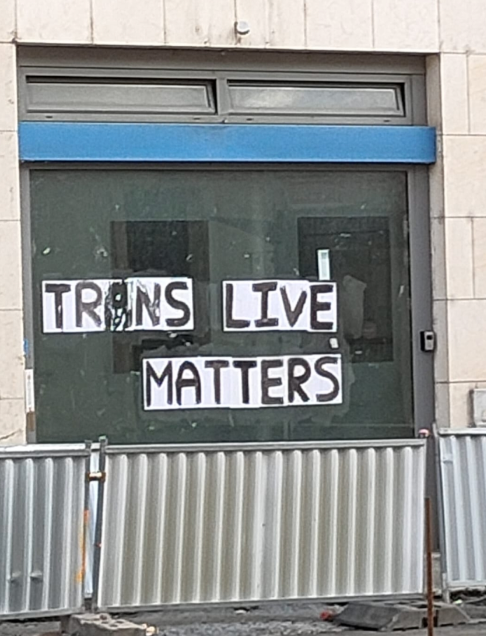
Structure
1. Warm-up: some definitions
2. Representation matters
3. How design shapes inclusion
- Binary title choice;
- Legal and preferred names;
- Deadname;
- Gender(s);
- Sex;
- Pronouns;
- Discrete push notifications;
- Stereotypical representation;
4. Creating inclusive forms
5. Conclusions
Warm-up: some definitions
- transgender person: a person who does not identify with their sex assigned at birth (MtoF = Male-to-Female; FtoM= Female-to-Male)
- cisgender person: a person who identifies with their sex assigned at birth
- non-binary person: a subgroup of the trans spectrum. People whose gender identity is neither exclusively female nor exclusively male.
- outing: the act of revealing a person’s homosexuality, bisexuality, transidentity, non-binarity, intersex, pansexuality, or asexuality without their consent or even against their will.
Representation matters
Have you ever spoken to a trans person?
A new Pew Research Center survey finds that four-in-ten Americans (42%) know someone who is transgender, up 5 percentage points since 2017.
Though the number of Americans who say that they personally know someone who is transgender has grown, 84% of Americans continue to learn about transgender people through the media — Nick Adams, Director of Programs for Transgender Media at GLAAD (source)
Most of the information we get about who transgender people are, what their lives are like, and who they are, comes from the media.
In the 60s and the 90s, the media trained us to make fun of trans people (e.g. film “Mrs. Doubtfire”, 1993: Robin Williams is dressed as a woman to be hired as a babysitter for his children), to be afraid of them (e.g. film “Psycho”, 1960: the serial killer is a psychopath that dresses as a woman), or to aggressively out them (e.g. film “Ace Ventura”, 1996: Jim Carrey tears off a colleague’s clothes in public to show that she’s not a “real woman”, and all the people who slept with her throw up at the same time).
Nowadays, representation is rising. In the series “Orange is the new black” (2013–2019), the transgender actress Laverne Cox plays the role of Sophia Burset, a woman sent to prison for credit card fraud. The actor Elliot Page did his trans coming out in 2020. The make-up artist Nikkie Tutorial came out as trans to her fans in 2020 following some threats, and her coming out video was seen more than 38 million times.
Still, some films keep featuring cis men playing trans women (e.g. Jared Leto in “Dallas Buyers Club” (2013), “Eddie Redmayne” in The Danish Girl (2015), and Benedict Cumberbatch in “Zoolander 2” (2016)). Like in Shakespeare’s time, when women were played by men. This is problematic because trans people are further ridiculed, and real trans people are not seen on screen.
But why does representation matter?
Representation helps to shape the way that people think about and understand the world. When certain groups or ideas are consistently underrepresented or misrepresented, it can lead to a distorted or limited understanding of those groups or ideas. This can have serious consequences, including discrimination, prejudice, and even violence.
According to Stonewall:
- Nearly 1 in 4 (23%) LGBT people have witnessed discriminatory or harmful remarks against LGBT people by healthcare staff.
- 7 in 10 (70%) transgender people report experiencing transphobia when accessing general health services.
- 2 in 3 (64%) LGBTQ+ people have experienced anti-LGBT+ violence or abuse.
- Most governments deny trans people the right to legally change their names and genders from those assigned to them at birth. (keep this point in mind, we’re addressing it in our research insights)
- ¼ of the world’s population believes that being LGBT should be a crime.
How design shapes inclusion
There are a number of reasons why design may be exclusive or difficult for trans users to navigate. Here are a few possible reasons:
Binary title choice
A title is used to refer to someone from the point of view of civil status. Many forms only offer a binary choice of “Mister” or “Madam” as options for titles. This can be exclusive and invalidating for non-binary people.
Moreover, civility has no legal value, and 5% of Americans between 18 and 30 years old consider themselves non-binary.
If we welcomed our customers in a physical store, would we ask about their titles?
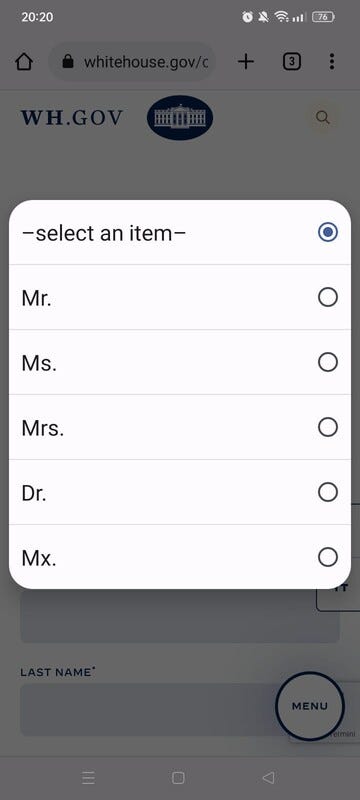
Legal and preferred names
Some forms may require the use of legal names (aka birth names), which can be problematic for trans individuals who have not yet changed their name legally or who prefer to use a different name than the one listed on their legal documents.
- Preferred name. For added inclusion, registration forms may allow users to add a preferred name, and also to make their own first name confidential and known just by the administration.

- Legal name change. Inclusive design also allows users to easily change their legal name, or to use a nickname. Let’s take the example of Paypal: Paypal shares their users’ names when they are transferring money, so they should be able to change their legal name or use a nickname in order not to be outed against their will.
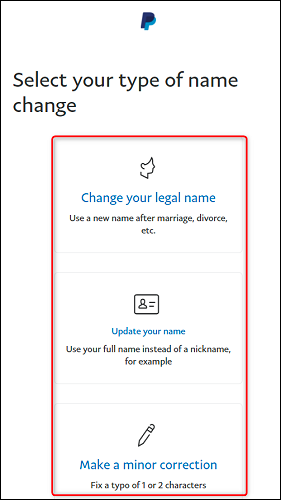
- Free legal name change. Hera Comm is a sales company that operates in Italy carrying out activities in various energy markets. If a client changes their legal name in documents, then they don’t have to pay the transfer of their contract.
Deadname
If a transgender person changed their legal name to a preferred name, then their former legal name becomes their deadname. If so, addressing them by their deadname is a lack of respect.
If someone becomes a public figure before coming out as trans, then their dead name is already known online. It would be still possible to do Google searches by their deadname. A more inclusive design could introduce a banner educating users about deadnaming and introducing them to the new name of this public figure.
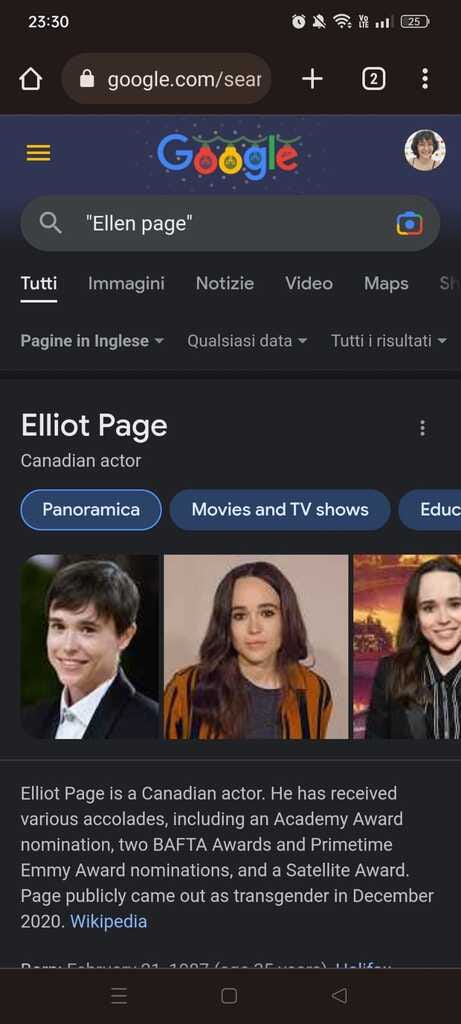
Everyone changing their legal name can find themselves in this delicate situation, for example, if they published books or research before the transition. How to make sure that their deadname no longer appears in searches, so as to avoid forced and continuous outing?
Gender(s)
Gender is belonging to one of the two sexes from a cultural rather than biological point of view.
Dating sites and apps quickly questioned gender in design, as it is their core business. They often have more inclusive forms, including a whole spectrum of genders.
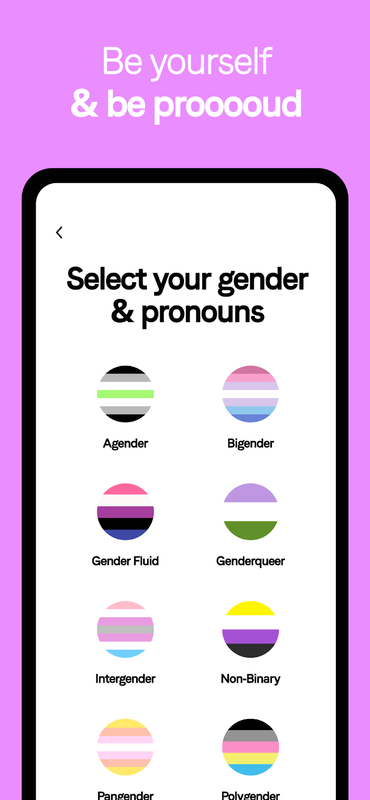
Sex
Some apps or sites may ask for users’ sex for a variety of reasons, more likely in a medical context or for statistical purposes.
As this question may be considered very intimate, then designers should question if they really need it.
If so, then it’s preferable to offer 3 options (male, female, and intersex), including why we need this information and provide further details to trans people to help them answer correctly.
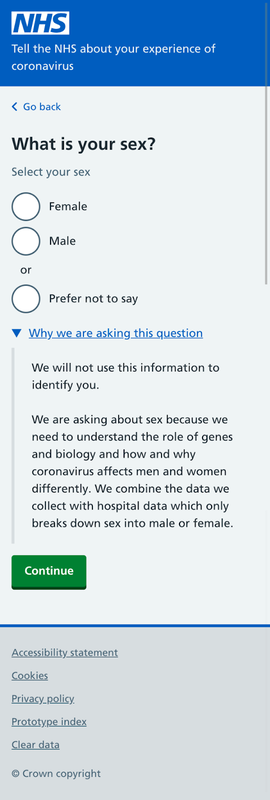
Pronouns
Lots of social media let users write down their own pronouns to avoid misgendering. The habit of giving pronouns rather than assuming them based on appearance or first name aims to support the passing of trans people. Passing means perceiving someone as a gender or sex other than the sex they were assigned at birth.
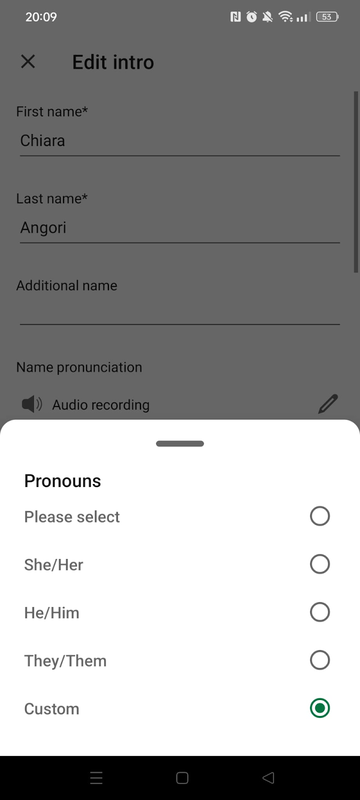
Discrete push notifications
Push notifications can be easily read by someone who’s not the owner of the smartphone.
Trans Memo is an app that helps trans people track their intake of hormones, and it enables “Discrete mode” for push notifications. Their text can be replaced by the user with free text.
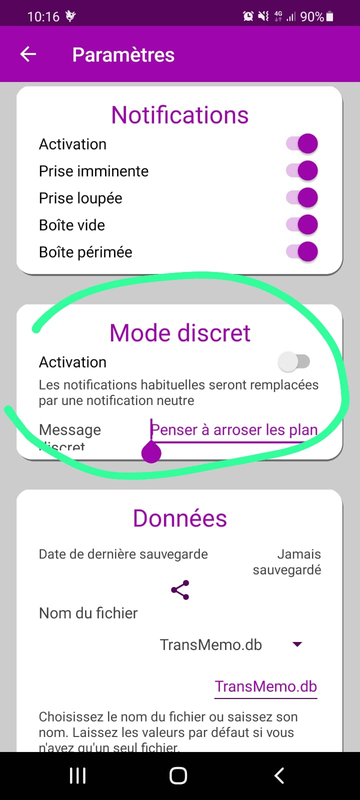
Stereotypical representation
The exclusion of trans people may also be conveyed by graphic images related to gender stereotyping. Sports apps may portray binary bodies and promote exercises targeted at specific body parts.
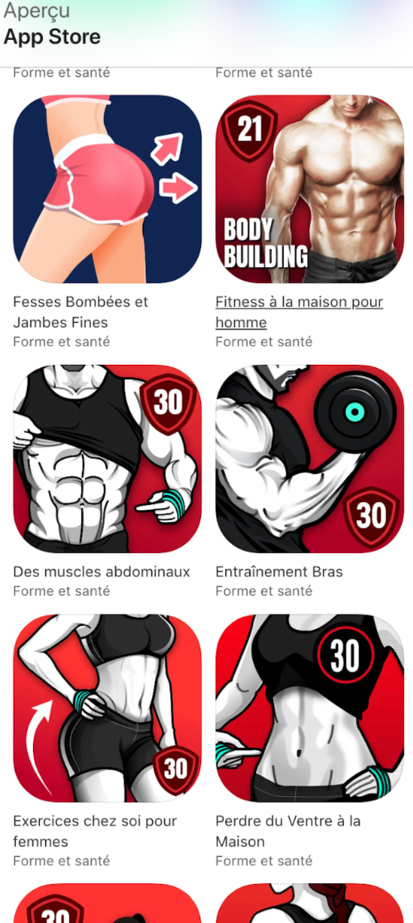
Colors can also be a vehicle for stereotyping: menstrual tracker apps often use pink and cute animals. Trans men may need these apps too, and may not be comfortable with these choices.
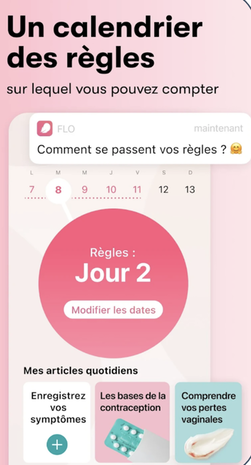
Co-creating inclusive forms
Everyone hates forms. When you ask users to register, you tell them that this will not be their last visit and that you intend to create a relationship with them. Users hate them so much, that an eCommerce site increased its annual revenues by $300 Million just by allowing users to skip registration.
We decided to focus our research on how to create the most inclusive registration form.
We created and tested 3 registration forms for a fictional social media, called "UrBuddy":
- quantitative research on Google Forms: 45 answers, 55.6% of respondents have between 18 and 30 years old, 15/45 are trans people, and 9/45 are non-binary people
- qualitative research: user interviews with 4 trans people
Form #1: neutral form
Form #1 is inspired by the registration form on Twitch. This form has no field related to sex, gender, title, or name, and it uses non-gendered language.
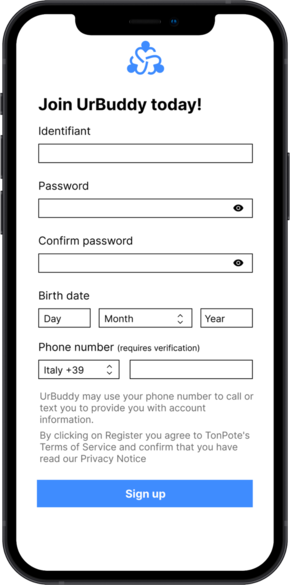
Here is our respondents’ feedback on it:
Gender precision is not useful for the use of most applications and websites, and does not necessarily improve the user experience either. A username, email, or nickname is preferable to be more inclusive while still being customizable. — user 23
Gender identity is not mentioned. It doesn’t add anything. — user 42
I feel like is way less invasive. — user 10
Form #2: option “I’d rather not say”
Form #2 is inspired by a step in the registration form in BlaBlaCar. This form asks users if they want to be called Mister or Madam, and has a third “I’d rather not say” option.
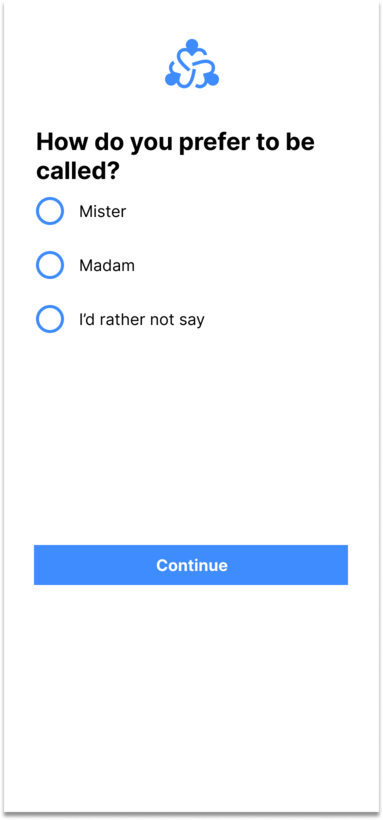
Here is our respondents’ feedback on it:
I find the sentence “I’d rather not say” almost accusatory. — user 18
I’m not comfortable with the “I’d rather not say”, as if it were something to keep secret. — user 15
The Mr/Ms is no longer relevant. — user 9
A lot of people think it [asking for someone’s title] is polite, but it’s more annoying than anything else. The third option shows that there is an effort made, but I would be afraid of being discriminated against if I checked the third option.
If I only have Mrs. or Mr., I put what I pass most. For example, I put Mrs. if I have to call on the phone, as I have a more feminine voice. It’s for my safety. — user 22
Form #3: option “I’d rather not say” + explanation
Form #3 is inspired by a survey done by NHS for Covid-related statistics. This form asks users if they want to be called Mister or Madam, has a third “I’d rather not say” option, and includes an explanation of why we are asking for this information.
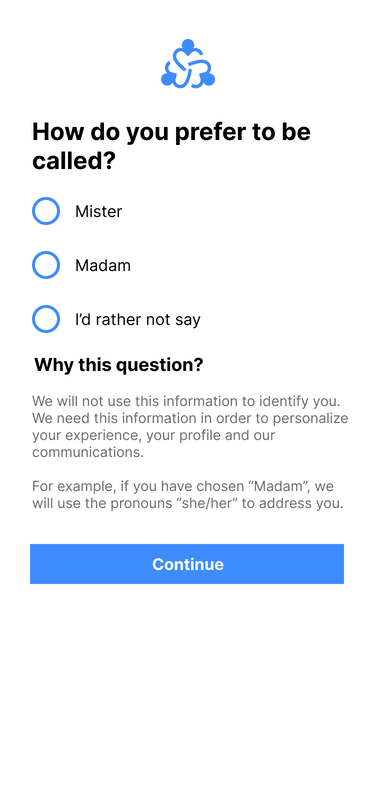
Here is our respondents’ feedback on it:
The explanation of “personalize your experience” also makes me uncomfortable because I would be afraid that my experience of the service would be influenced by the pronouns used — user 36
Proposal 3, without being perfect, seems to me to be the best compromise between the respect of the user and the (business) intention of the company that wishes to onboard a new customer! — user 16
The “transparency” displayed is commendable but it could go further and propose other pronouns and titles, for example. Here, we remain in the woman / man / hidden under the table. — user 31
Forms #1, #2, #3: conclusions
Form #1 is considered the most inclusive one, as it has no field related to sex, gender, title, or names, and it uses non-gendered language.
Form #2 and #3 are considered a step forward to binary titles.
The wording of the 3rd option is a common pattern (“I’d rather not say”), but it is considered offensive and accusatory by most of the respondents.
The explanation itself is commendable but leads to uncertainty (“How will my experience be customized?”): trans users do not want to be treated differently and are suspicious to share such personal info in an app they don’t trust.
As a trans person I would like to know why my data is important and have the option to hide my first name. I need a safe environment and to feel confident! — user 31
Focus on legal and preferred names
As told before, most governments deny trans people the right to legally change their names and genders from those assigned to them at birth.
When we asked our 15 trans respondents if they changed their documents or were interested in doing it, 15 out of 15 told us they already did or wanted to do it.
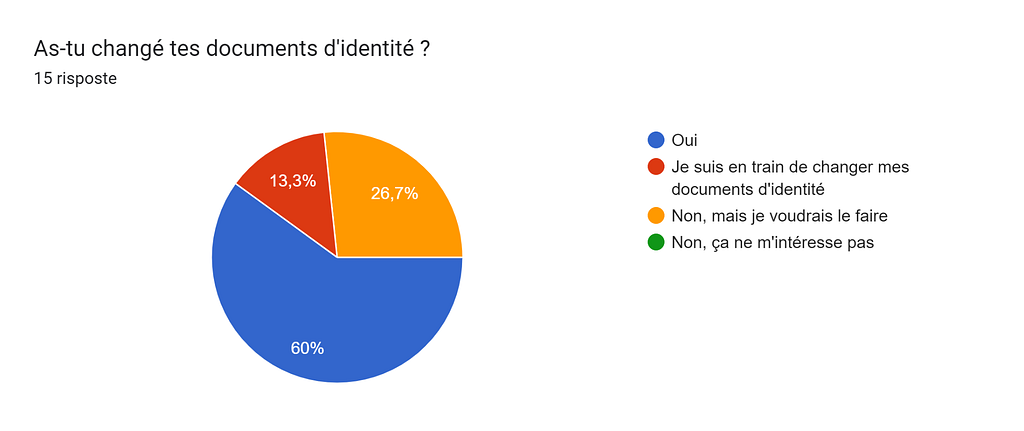
So, here is a section on UrBuddy to let users mark their birth name as confidential, and insert a preferred name.
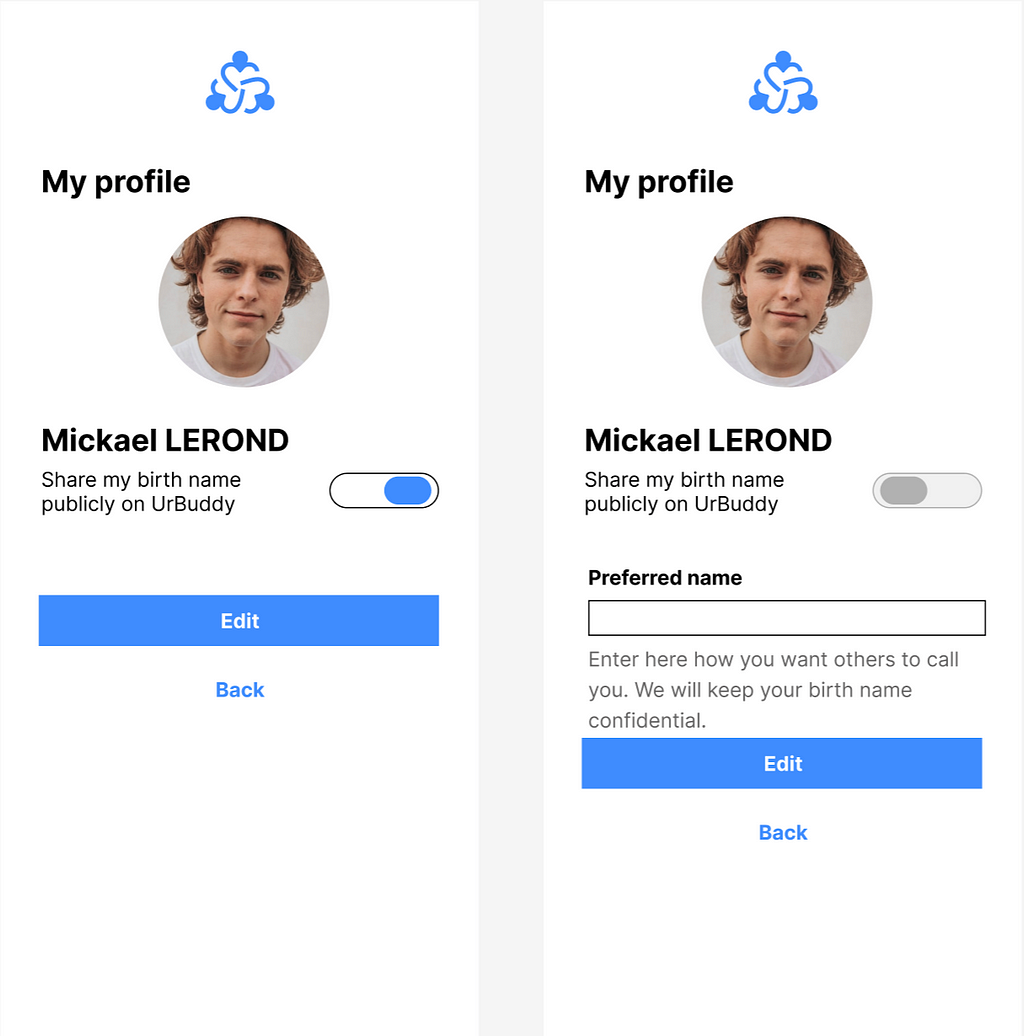
Conclusion
We decided to deep dive into this topic because we strongly believe that answering trans people’s needs can create a safer digital environment, help the LGBTQI+ community trust in brands (beware of pinkwashing) and promote a more diverse workforce in Tech.
We leave you with two quotes: they pushed us to do this research work, and have made us feel that every designer has a responsibility to create enjoyable and socially committed experiences.
When the needs of trans people are made explicitly visible within an interface, everyone who uses that interface gets a subtle reminder that trans people exist. […] Changing form field won’t change laws. But the more our daily interactions and tasks happen in digital spaces, the more power those spaces hold over cultural norms. Every form field, every default setting, every push notification, affects people. Every detail can add to the culture we want — can make people a little safer, a little calmer, a little more hopeful. — Technically Wrong: Sexist Apps, Biased Algorithms, and Other Threats of Toxic Tech — Sara Wachter-Boettche
A few months ago, I worked on the redesign of an entertainment web portal. One of the main obstacles was rethinking the forms, not only in their writing but also in the thinking behind them. The questions on a form say more about the person asking them than the person answering them — Scrivi e lascia vivere — V. De Michele, A. Orrù, A. Fiacchi
Acknowledgments
This research came about by accident, like almost all good things.
I would like to thank Paris Web, the first conference I attended as a speaker, for the trust and organization.
Huge kudos to my dear colleague Christopher, for his passion, his time, and our good times spent together (even stage fright).
And thanks to the 45 people who made it all possible by responding to a form spammed all over the internet. We owe you a lot.
PS: here is my LinkedIn profile if you want to chat about this topic ✨
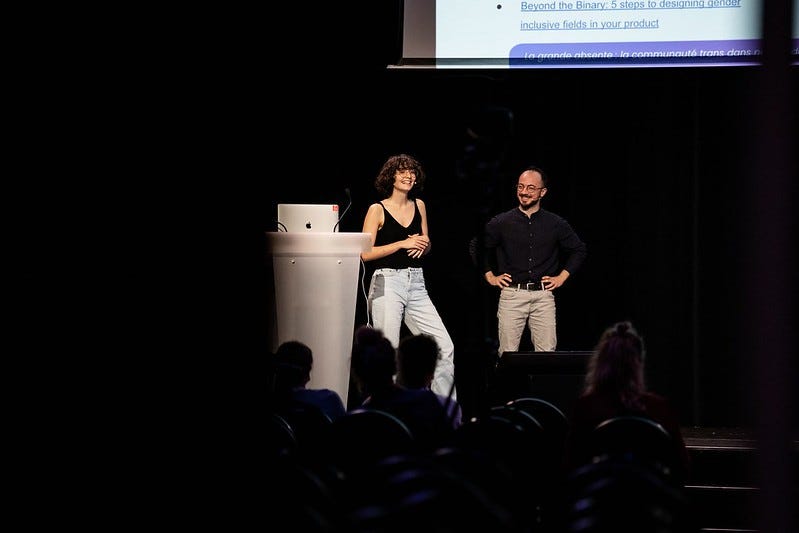
Additional sources (English)
- The Gender-Inclusive Language Project
- More Than A Matter Of Pride: Addressing How Transgender And Non-Binary Banking Customers Are Treated
- Designing forms for gender diversity and inclusion
- Beyond the Binary: 5 steps to designing gender-inclusive fields in your product
- How Designers Destroyed the World ou la responsabilité du designer UX, Mike Monteiro
- Trans day of visibility 2022
- “Disclosure” — Netflix Documentary
- “Invisible Women: Exposing Data Bias in a World Designed for Men”, Caroline Criado Perez, 2019
- “Whipping Girl: A Transsexual Woman on Sexism and the Scapegoating of Femininity”, Julia Serano, 2007
Additional sources (French)
- Rapport relatif à la santé et aux parcours de soins des personnes trans
- Changement de sexe dans les actes de l’état civil
- Le changement d’état civil
- Transidentités : écouter pour mieux concevoir
- Le travestissement sexuel au théâtre
- “Une histoire de genres”, Lexie, 2021
- “TTT, Tandem de Témoignages Transgenres”, Roxanne Sharks et Christel Seval, 2019
- “Transfuges de sexe”, Emmanuel Beaubatie, 2021
- uxetgenre.com
- Épisode “je suis transgenre” — Tartine de vie
Building inclusive products for trans people was originally published in UX Collective on Medium, where people are continuing the conversation by highlighting and responding to this story.